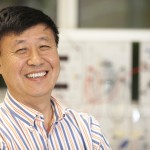Griffith University researchers continue to lead the way in harnessing renewable energy sources that will be the next generation of clean fuel, as well as enhanced solar conversion and energy storage devices.
The latest research presented in the paper Ultrathin metal—organic framework nanosheets for electrocatalytic oxygen evolution, published in Nature Energy, shows that an ultrathin catalyst could be used to split water into its two components, oxygen and hydrogen, which can then be converted to be used as a fuel.
While it is already scientifically possible to split water in this way, highly efficient catalysts like this are the key to moving the system to one that is economically viable.
Professor Huijin Zhao, the Director of Griffith’s Centre for Clean Environment and Energy (CCEE) says just as solar light can generate electricity, the water splitting process could do the same via the generation of clean chemical fuel such as hydrogen.
“The world is now facing five major issues for humanity — energy, environment, water, food security and public health,” he says.
“Global warming is ranked first and it’s all resulting from burning fossil fuels because that’s where carbon dioxide comes from.
“To reduce this and to make the global temperature not rise beyond 2C you have to find clean, renewable energy and hydrogen equals clean energy.
“It’s part of the solution — if we really can split water into two that will be one scientific solution for the future of sustainable energy supplies.”
Prof Zhao said hydrogen would be a promising clean fuel over petrol in forseable future.
“Scientifically it’s already demonstrated, it’s already working but to do this in a way that’s economically viable, there’s still a bit of work to do and we need government policy, general public support, and you also need those big companies to realise they should not dig up out of the ground anymore,” he said.
“It’s not just a simple technology issue.”
Prof Zhao, who also sits within the Environmental Futures Research Institute,was also recently awarded$401,000in the Australian Research Council Projects for 2017 for 2D-Nanoporous Structured High Performance Gas Evolution Electrocatalysts.
Heterogeneous electrocatalytic gas evolution reactions hold a key for clean energy generation and storage technologies, but their efficiencies are severely hindered by high overpotentials caused by slow gaseous products detachment from catalyst surface.
Overpotentials represent the extra energy required to make a chemical reaction to occur. The higher the overpotential, the higher the energy consumption.
This project aims to tackle this critical issue by developing novel two-dimensional ultrathin porous electrocatalysts with superior gas detachment properties and low overpotentials. The outcome of the project will provide sound scientific basis to design and develop high performance electrocatalysts for fuel gas production.

